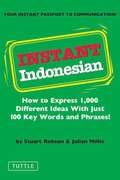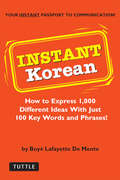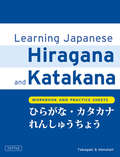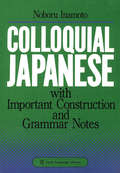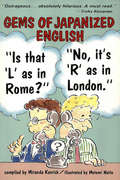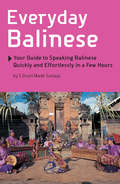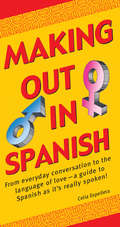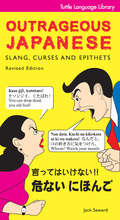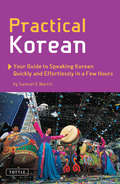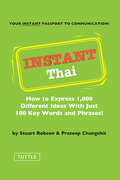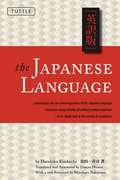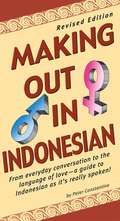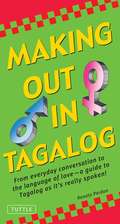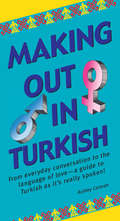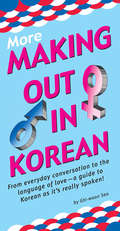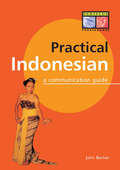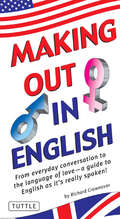- Table View
- List View
Instant Indonesian
by Julian Millie Stuart RobsonIt's amazing how 100 key words and phrases provide instant communication!Do you want to speak simple Indonesian but are too busy to study it? Are you visiting Indonesia for a short time and want an Indonesian phrase book to help you communicate? If so, this is the book for you. It includes all the essential content necessary to speak basic Indonesian.The idea of Instant Indonesian is simple-learn 100 words and phrases and say 1,000 things. The trick is knowing which 100 words to learn, but the authors Stuart Robson and Julian Millie have solved the problem, choosing only those words you'll hear again and again. Even with a vocabulary this small, you'll be surprised how quickly and fluently you too can communicate in Indonesian. Words are repeated in different combinations, building familiarity without effort. A brief guide to pronunciation allows the user to say the phrases correctly. Here's a sample of what you'll be able to do:Meet peopleGo shoppingAsk directionsRide the subwayOrder food and drinksAnd much more
Instant Korean
by Boyé Lafayette De MenteIt's amazing how 100 key words and phrases provide instant communication!Do you want to speak simple Korean but are too busy to study it? Are you visiting Korea for a short time and want a Korean phrase book to help you communicate? If so, this Korean phrasebook for you. It includes all the necessary information to speak basic Korean.The idea of Instant Korean is simple--learn 100 words and phrases and say 1,000 things. The trick is knowing which 100 words to learn, but the author Boye Demente has solved the problem, choosing only those words you'll hear again and again. Even with a vocabulary this small, you'll be surprised how quickly and fluently you too can communicate in Korean. Here's a sample of what you'll be able to do with this Korean phrasebook:Meet peopleGo shoppingAsk directionsRide the subwayOrder food and drinksAnd much more
Learning Japanese Hiragana and Katakana
by Kenneth Henshall Tetsuo TakagakiLearning Hiragana and Katakana is a systematic and comprehensive workbook that can be used along with a Japanese language textbook or as a stand-alone resource to learn the Japanese alphabet (kana).Japanese has 3 writing systems, all used together: hiragana, katakana and kanji. Learning Japanese Hiragana & Katakana helps newcomers learn how to use the first two systems' basic 92 characters to read, write and communicate. With expanded writing and preparation space, this revised edition offers ample provisions for practice, review and self-testing at several levels. It also includes a detailed reference section explaining the origin and function of kana and the various kana combinations. Complete with a detailed pronunciation guide, this volume will prove invaluable for beginning students or those accustomed to romanized Japanese (romanji). This workbook is a perfect companion to Tuttle Publishing's Japanese Hiragana & Katakana for Beginners or any other Japanese textbook on the market.This workbook includes:Systematic and comprehensive coverage of the two kana systemsAmple provision for kana practice, review, and self-testing at several levelsDetailed reference section explaining the origin and function of kana, and the various kana combinationsHelpful additional information for language students accustomed to romanized JapaneseJapanese pronunciation guidance for all basic soundsVocabulary selected for usefulness and cultural relevance
Colloquial Japanese
by William Dale JenningsColloquial Japanese, a systematic study, is based on the idea that a language is composed of fundamental paton the idea that a language is composed of fundamental patterns in the same way a building is constructed of bricks. Instead of theoretical rules of grammar, patterns of usage are systematically introduced to create live, useful language. These patterns are presented as they are used in daily speech by Japanese, then reinforced with additional examples and explanations. Just as each brick must be placed one after the other to construct a building, each pattern of Japanese is taught one by one, to build a sound structure for the mastery of the language.The essentials of pronunciation and intonation are clearly explained and diagrammed throughout the book. Each chapter includes important expressions for everyday use, as well as exercises and drills that provide a thorough command of new patterns. The student is taught first the most frequently used polite language, then introduced to both informal and superpolite language. A complete index of grammar points is included, and appendices serve as additional tools for study and review. Vocabulary lists contain all the Japanese words used in the book, as well as other important terms and expressions. The result is a complete course in basic Japanese, systematically and lucidly presented, designed especially for those wishing to improve their verbal skills.
Gems of Japanized English
by Miranda KenrickJapanese do things better, this book may be the ideal antidote. Even the Japanese are quick to admit that despite their enthusiasm for learning it, they still have a certain amount of difficulty with the English language.This is no new phenomenon. Shortly after Japan opened her ports to foreign traders, one doctor advertised himself as "a Specialist in the Decease of Children"; eggs were sold as "extract of fowl" ; and a notice advised that "Tomorrow, from midnight to 12 noon, you will receive dirty water. " Fortunately, things are improving, but very slowly. A more recent English-language newspaper reported that someone's "wedding was consummated in the garden of the American consul's home," while a road sign was posted near a busy intersection that commanded drivers to "Have many accidents here."Long-time Tokyo resident Miranda Kenrick has collected these and hundreds of other delightful anecdotes to form a lighthearted, but unabashedly affectionate, portrait of the J apanese at home. R eading this book may do more for U.S.-Japan relations than a whole bookshelf of more seriousminded tomes.
Gems of Japanized English
by Miranda KenrickJapanese do things better, this book may be the ideal antidote. Even the Japanese are quick to admit that despite their enthusiasm for learning it, they still have a certain amount of difficulty with the English language.This is no new phenomenon. Shortly after Japan opened her ports to foreign traders, one doctor advertised himself as "a Specialist in the Decease of Children"; eggs were sold as "extract of fowl" ; and a notice advised that "Tomorrow, from midnight to 12 noon, you will receive dirty water. " Fortunately, things are improving, but very slowly. A more recent English-language newspaper reported that someone's "wedding was consummated in the garden of the American consul's home," while a road sign was posted near a busy intersection that commanded drivers to "Have many accidents here."Long-time Tokyo resident Miranda Kenrick has collected these and hundreds of other delightful anecdotes to form a lighthearted, but unabashedly affectionate, portrait of the J apanese at home. R eading this book may do more for U.S.-Japan relations than a whole bookshelf of more seriousminded tomes.
Everyday Balinese
by I Gusti SutjajaThis is a concise and user-friendly guide to learning basic BalineseEveryday Balinese is targeted to anyone who wishes to learn to speak colloquial Balinese. There are 23 lessons in the book, each with a dialogue that centers around the Balinese daily life. The dialogue is presented twice: The first version representing the lumrah or common Balinese; the second the alus or refined Balinese. Both versions are exactly the same grammatically; the difference lies in the word choice. Lumrah or common words are used by participants of equal social status in a conversation, and it reflects intimacy and informality among the users. Alus or refined words are associated with distancing and formality among users in a conversation.Each lesson contains a section on the grammar an word function, as well as a list of words in both the lumrah and alus forms, followed by their Indonesian and English equivalents. Each lesson ends with a section on sentence construction-how to use the structures taught to make simple sentences.The book has a pronunciation guide at the front, and a section or greeting, ordinal numbers and a handy dictionary at the end. The dictionary is arranged alphabetically by Balinese, followed by Indonesian and English equivalents.
Everyday Balinese
by I Gusti SutjajaThis is a concise and user-friendly guide to learning basic BalineseEveryday Balinese is targeted to anyone who wishes to learn to speak colloquial Balinese. There are 23 lessons in the book, each with a dialogue that centers around the Balinese daily life. The dialogue is presented twice: The first version representing the lumrah or common Balinese; the second the alus or refined Balinese. Both versions are exactly the same grammatically; the difference lies in the word choice. Lumrah or common words are used by participants of equal social status in a conversation, and it reflects intimacy and informality among the users. Alus or refined words are associated with distancing and formality among users in a conversation.Each lesson contains a section on the grammar an word function, as well as a list of words in both the lumrah and alus forms, followed by their Indonesian and English equivalents. Each lesson ends with a section on sentence construction-how to use the structures taught to make simple sentences.The book has a pronunciation guide at the front, and a section or greeting, ordinal numbers and a handy dictionary at the end. The dictionary is arranged alphabetically by Balinese, followed by Indonesian and English equivalents.
Making Out in Spanish: (Spanish Phrasebook)
by Celia EspelletaMaking Out in Spanish is a fun, accessible and thorough Spanish phrase book and guide to the Spanish language as it's really spoken.<P><P>If you are a student, businessman or tourist traveling to Latin America or Spain and would like to have an authentic and meaningful experience, the key is being able to speak like a local. This friendly and easy-to-use Spanish phrasebook makes this possible. Making Out in Spanish has been carefully designed to act as a guide to modern colloquial Spanish for use in everyday informal interactions-giving access to the sort of catchy Spanish expressions that aren't covered in traditional language materials. As well as the Latin script, each expression is now given in phonetics, making pronunciation a breeze. (For example, Buana idea! is also written as BWE-na ee-DE-a!).This Spanish phrasebook includes:Information about Latin American Spanish vs. Spain Spanish as well as regional dialectsA guide to pronouncing Spanish words correctlyExplanations of basic Spanish grammar, such as question forms, male vs. female, formal vs. informal and vowel stressComplete Spanish translations including phonetic scriptUseful and interesting notes on Spanish language and cultureLots of colorful, fun and useful expressions not covered in other phrasebooks
Outrageous Japanese
by Jack SewardThis is a user-friendly and concise Japanese phrase book and guide to Japanese slang and Japanese curses.The Japanese are extraordinarily polite and soft-spoken people who are always indirect and evasive in their dealings with each other. Right? Well, not really. They can be just as explicit, vicious, vile and downright vulgar as anyone else when they want to be. This little gem of a book teaches you hundreds and hundreds of Japanese taunts, threats, curses and expletives that you'll never find in any dictionary-showing you how the Japanese really talk to one another when they are angry or emotional. Fun and entertaining, it will help you to read Japanese, write Japanese, and speak Japanese. It leaves no taboo untouched and sets the record straight. Learn how to call somebody a lecher, a deadbeat, a tub of lard, (and much worse than we can show here)-and arm yourself with phrases such as "Drop dead" or "what sewer did you crawl out of jackass? Fun and instructive, it is the perfect antidote for those boring language classes you have been taking, and your Japanese friends will die when they hear you trying out new expressions like tonji (pig-child) and dauma-geisha (fat-bottomed geisha).
Outrageous Japanese
by Jack SewardThis is a user-friendly and concise Japanese phrase book and guide to Japanese slang and Japanese curses.The Japanese are extraordinarily polite and soft-spoken people who are always indirect and evasive in their dealings with each other. Right? Well, not really. They can be just as explicit, vicious, vile and downright vulgar as anyone else when they want to be. This little gem of a book teaches you hundreds and hundreds of Japanese taunts, threats, curses and expletives that you'll never find in any dictionary-showing you how the Japanese really talk to one another when they are angry or emotional. Fun and entertaining, it will help you to read Japanese, write Japanese, and speak Japanese. It leaves no taboo untouched and sets the record straight. Learn how to call somebody a lecher, a deadbeat, a tub of lard, (and much worse than we can show here)-and arm yourself with phrases such as "Drop dead" or "what sewer did you crawl out of jackass? Fun and instructive, it is the perfect antidote for those boring language classes you have been taking, and your Japanese friends will die when they hear you trying out new expressions like tonji (pig-child) and dauma-geisha (fat-bottomed geisha).
Outrageous Japanese
by Jack SewardThis is a user-friendly and concise Japanese phrase book and guide to Japanese slang and Japanese curses.The Japanese are extraordinarily polite and soft-spoken people who are always indirect and evasive in their dealings with each other. Right? Well, not really. They can be just as explicit, vicious, vile and downright vulgar as anyone else when they want to be. This little gem of a book teaches you hundreds and hundreds of Japanese taunts, threats, curses and expletives that you'll never find in any dictionary-showing you how the Japanese really talk to one another when they are angry or emotional. Fun and entertaining, it will help you to read Japanese, write Japanese, and speak Japanese. It leaves no taboo untouched and sets the record straight. Learn how to call somebody a lecher, a deadbeat, a tub of lard, (and much worse than we can show here)-and arm yourself with phrases such as "Drop dead" or "what sewer did you crawl out of jackass? Fun and instructive, it is the perfect antidote for those boring language classes you have been taking, and your Japanese friends will die when they hear you trying out new expressions like tonji (pig-child) and dauma-geisha (fat-bottomed geisha).
Practical Korean: Your Guide to Speaking Korean Quickly and Effortlessly in a Few Hours
by Samuel E. MartinA handy introduction to the Korean language that is concise, simple, and useful.This book has been written to fill a specific need: that of the hundreds of thousand of people now visiting Korea for business or holidays or even living there for a year or two, who wish to learn something of the spoken Korean language around them. <P><P>The grammatical structure of Korean is particularly complex, and difficulties plague foreign students learning Korean. Samuel E. Martin, renowned Asian language expert and professor emeritus at Yale University has simplified some of the common problems to acquaint the reader with the most useful way to say a lot of everyday things, without having to memorize long lists of grammatical rules. The compact size makes it ideal for traveling to Korea or reading on a plane, train or bus. The student will quickly make progress learning to comprehend and speak Korean. The material is presented using the romanization method of written Korean that is officially authorized by the Korean government as well as the native Korean script (Hangeul). Practical Korean is grouped into 47 lessons that cover all the common topics of conversation, grammar and vocabulary.
Instant Thai: How to Express 1,000 Different Ideas with Just 100 Key Words and Phrases! (Thai Phrasebook)
by Stuart Robson Prateep ChangchitIt's amazing how 100 key words and phrases provide instant communication!Do you want to speak simple Thai but are too busy to study it? Are you visiting Thailand for a short time and want a Thai phrase book to help you communicate? If so, this is the book for you. It includes all the necessary information to speak basic Thai.The idea of Instant Thai is simple-learn 100 words and phrases and say 1,000 things. The trick is knowing which 100 words to learn, but the authors Stuart Robson and Prateep Changchit have solved the problem, choosing only those words you'll hear again and again. Even with a vocabulary this small, you'll be surprised how quickly and fluently you too can communicate in Thai. It also has an English-Thai wordlist, arranged alphabetically. At the end of the book are useful appendices for telling the time, kinship terms, some Thai proverbs, and emergency expressions. Here's a sample of what you'll be able to do:Meet peopleGo shoppingAsk directionsRide the subwayOrder food and drinksAnd much more
Instant Thai: How to Express 1,000 Different Ideas with Just 100 Key Words and Phrases! (Thai Phrasebook)
by Stuart Robson Prateep ChangchitIt's amazing how 100 key words and phrases provide instant communication!Do you want to speak simple Thai but are too busy to study it? Are you visiting Thailand for a short time and want a Thai phrase book to help you communicate? If so, this is the book for you. It includes all the necessary information to speak basic Thai.The idea of Instant Thai is simple-learn 100 words and phrases and say 1,000 things. The trick is knowing which 100 words to learn, but the authors Stuart Robson and Prateep Changchit have solved the problem, choosing only those words you'll hear again and again. Even with a vocabulary this small, you'll be surprised how quickly and fluently you too can communicate in Thai. It also has an English-Thai wordlist, arranged alphabetically. At the end of the book are useful appendices for telling the time, kinship terms, some Thai proverbs, and emergency expressions. Here's a sample of what you'll be able to do:Meet peopleGo shoppingAsk directionsRide the subwayOrder food and drinksAnd much more
Instant Thai
by Prateep Changchit Stuart RobsonIt's amazing how 100 key words and phrases provide instant communication!Do you want to speak simple Thai but are too busy to study it? Are you visiting Thailand for a short time and want a Thai phrase book to help you communicate? If so, this is the book for you. It includes all the necessary information to speak basic Thai.The idea of Instant Thai is simple-learn 100 words and phrases and say 1,000 things. The trick is knowing which 100 words to learn, but the authors Stuart Robson and Prateep Changchit have solved the problem, choosing only those words you'll hear again and again. Even with a vocabulary this small, you'll be surprised how quickly and fluently you too can communicate in Thai. It also has an English-Thai wordlist, arranged alphabetically. At the end of the book are useful appendices for telling the time, kinship terms, some Thai proverbs, and emergency expressions. Here's a sample of what you'll be able to do:Meet peopleGo shoppingAsk directionsRide the subwayOrder food and drinksAnd much more
The Japanese Language
by Haruhiko Kindaichi Umeyo Hirano Mineharu NakayamaThis is a book about the structure, history and evolution of the Japanese languageThe Japanese Language is a classic study of one of the world's most widely used but least understood languages. Emphasizing the richness and complexity of Japanese as well as its limitations, this fine book provides a lively discussion about the uniqueness of the Japanese language.This book will interest anyone intrigued by one of the word's most widely used and least understood languages. The relationship of Japanese to other languages is not well understood even by native speakers, and Proffessor Kindaichi sets out to define it. He concludes that Japanese is indeed only remotely related to other world languages although it shares many features in common with the languages of mainland AsiaReaders who are just beginning Japanese study will find this section especially fascinating, for each point is backed by examples from literature and everyday speech. Kindaichi also investigates the so-called vagueness of Japanese and traces it to its source-the unusual sentence order. This book includes:The highly debated origins of the Japanese languageDialects, jargon, sex- and role-based distinctionsDifferences between informal, formal, and literary langaugeStructure, rhythm, and accent of pronunciationWhat can and cannot be said in Japanese
The Japanese Language
by Umeyo Hirano Haruhiko Kindaichi Mineharu NakayamaThis is a book about the structure, history and evolution of the Japanese languageThe Japanese Language is a classic study of one of the world's most widely used but least understood languages. Emphasizing the richness and complexity of Japanese as well as its limitations, this fine book provides a lively discussion about the uniqueness of the Japanese language.This book will interest anyone intrigued by one of the word's most widely used and least understood languages. The relationship of Japanese to other languages is not well understood even by native speakers, and Proffessor Kindaichi sets out to define it. He concludes that Japanese is indeed only remotely related to other world languages although it shares many features in common with the languages of mainland AsiaReaders who are just beginning Japanese study will find this section especially fascinating, for each point is backed by examples from literature and everyday speech. Kindaichi also investigates the so-called vagueness of Japanese and traces it to its source-the unusual sentence order. This book includes:The highly debated origins of the Japanese languageDialects, jargon, sex- and role-based distinctionsDifferences between informal, formal, and literary langaugeStructure, rhythm, and accent of pronunciationWhat can and cannot be said in Japanese
Making Out in Indonesian: Revised Edition (Indonesian Phrasebook)
by Soe Tjen Marching Peter ConstantineMaking Out in Indonesian is a fun, accessible and thorough guide to Indonesian as it's really spoken. It has been updated and expanded to be even more helpful as a guide to modern colloquial Indonesian for use in everyday informal interactions-giving access to the sort of catchy expressions that aren't covered in traditional language materials.<P><P>It includes an introduction to the Indonesian language as well as a pronunciation guide, topical notes throughout on key points of language and culture, and chapters based on typical real-life encounters with speakers of Indonesian, including: o Making acquaintances o Discussing likes and dislikes o Sharing a meal o Going out on the town o Developing a romantic relationship or quarreling, even through to having sex and getting married or splitting up!
Making Out in Tagalog: (Tagalog Phrasebook)
by Renato PerdonMaking Out in Tagalog is a fun, accessible and thorough Tagalog phase book and guide to the Filipino language as it's really spoken.<P><P>If you are a student, businessman or tourist traveling to the Philippines and would like to have an authentic and meaningful experience, the key is being able to speak like a local. This friendly and easy-to-use Tagalog phrasebook makes this possible. Making Out in Tagalog has been carefully designed to act as a guide to modern colloquial Tagalog for use in everyday informal interactions-giving access to the sort of catchy Filipino expressions that aren't covered in traditional language materials. Each expression is given in Tagalog, so that in the case of difficulties the book can be shown to the person the user is trying to communicate with.This Tagalog phrasebook includes:A guide to pronouncing Tagalog words correctly including vowel combinations and stressing of wordsExplanations of basic Tagalog grammar, such as, word order, pronouns, borrowed words, and polite vs. impolite tensesUseful and interesting notes on Tagalog language and Filipino cultureLots of colorful, fun and useful expressions not covered in other phrasebooks
Making Out in Turkish: Turkish Phrasebook
by Ashley CarmanMaking Out in Turkish is a fun, accessible and thorough Turkish phrase book and guide to the Turkish language as it's really spoken.Sana hayranim! Seni tekrar ne zaman gorecegim?--(I adore you! When can I see you again?) Answer this correctly in Turkish and you may be going on a hot date.<P><P> Incorrectly, and you could be hurting someone's feelings or getting a slap! Turkish classes and textbooks tend to spend a lot of time rehearsing for the same fictitious scenarios but chances are while in Turkey you will spend a lot more time trying to make new friends or start new romances--something you may not be prepared for.If you are a student, businessman or tourist traveling to Turkey and would like to have an authentic and meaningful experience, the key is being able to speak like a local. This friendly and easy-to-use Turkish phrasebook makes this possible. Making Out in Turkish has been carefully designed to act as a guide to modern colloquial Turkish for use in everyday informal interactions--giving access to the sort of catchy Turkish expressions that aren't covered in traditional language materials. Each expression is given in authentic Turkish (turkce) so that in the case of difficulties the book can be shown to the person the user is trying to communicate with. In addition, phonetic spellings are also included making speaking Turkish a breeze. For example "Okay"--Tamam, is also given as ta-MAHM. This Turkish phrasebook includes:A guide to pronouncing Turkish words correctlyExplanations of basic Turkish grammar, such as, double letters, vowel harmony, agglutination, questions, and negationComplete Turkish translations including phonetic spellingsUseful and interesting notes on Turkish language and cultureLots of colorful, fun and useful expressions not covered in other phrasebooksTitles in this unique series of bestselling phrase books include: Making Out in Chinese, Making Out in Indonesian, Making Out in Thai, Making Out in Korean, Making Out in Hindi, Making Out in Japanese, Making Out in Vietnamese, Making Out in Burmese, Making Out in Tagalog, Making Out in Hindi, Making Out in Arabic, Making Out in English, More Making Out in Korean, and More Making Out in Japanese.
More Making Out in Korean: (Korean Phrasebook)
by Ghi-Woon SeoMore Making Out in Korea is a fun, accessible and thorough Korean phrase book and guide to the Korean language as it's really spoken.<P><P>This prasebook follows the bestselling Making Out in Korea providing additional (and classic) phrases for travelers, including ones to help you make acquaintances, discuss likes and dislikes, share a meal, go out on the town or develop a romantic relationship.This Korean phrasebook includes: A guide to pronouncing Korean words correctly. Explanations of basic Korean grammar, such as, word order, questions, and formal vs. informal tenses. Complete Korean translations including Korean Script (hangul). Useful and interesting notes on Korean language and culture. Lots of colorful, fun and useful expressions not covered in other phrasebooks.
Practical Indonesian Phrasebook: A Communication Guide
by John BarkerThis is a handy, travel-sized Indonesian phrasebook with additional information about the Indonesian language.<P><P>As any seasoned traveler knows, the ability to communicate in the language of the country you are visiting makes a very big difference in the experiences you have. Even a basic grasp of a few essentials will help you to relate to the people, get where you want to go, pay the right prices, and get much more out of your visit. That's the reason for this book which is designed especially for travelers to Indonesia and Malaysia. The emphasis is on effective communication, not grammar rules or tourist phrases. It is organized to be as simple, concise, and useful as possibly. With this book and a few hours of practice you can start communicating in Indonesian or Malay.The main focus of the book is Indonesia and Indonesian. However, since Malay is very closely related language, you will be able to make use of it quite effectively in both countries. Key features of Practical Indonesian Phrasebook are:Very compact travel sizeHundreds of useful Indonesian words and phrasesArranged by topic and situation for easy useIndonesian grammar, pronunciation and body-language guidesGlossary and appendix for easy reference and conversion to Malay
Making Out in English
by Richard CrownoverMaking Out in English is a fun, accessible and thorough English phrase book and guide to the English language as it's really spoken.If you are a student, businessman or tourist traveling to the English speaking world and would like to have an authentic and meaningful experience, the key is being able to speak like a local. This friendly and easy-to-use English phrasebook makes this possible. Making Out in English has been revised and redesigned to act as a guide to modern colloquial English for use in everyday informal interactions-giving access to the sort of catchy English expressions that aren't covered in traditional language materials. In the case of difficulties the book can be shown to the person the user is trying to communicate with.This English phrasebook includes:A guide to pronouncing English words correctlyExplanations of basic English grammarComplete translationsUseful and interesting notes on the English language and cultureLots of colorful, fun and useful expressions not covered in other phrasebooks
Making Out in English
by Richard CrownoverMaking Out in English is a fun, accessible and thorough English phrase book and guide to the English language as it's really spoken.If you are a student, businessman or tourist traveling to the English speaking world and would like to have an authentic and meaningful experience, the key is being able to speak like a local. This friendly and easy-to-use English phrasebook makes this possible. Making Out in English has been revised and redesigned to act as a guide to modern colloquial English for use in everyday informal interactions-giving access to the sort of catchy English expressions that aren't covered in traditional language materials. In the case of difficulties the book can be shown to the person the user is trying to communicate with.This English phrasebook includes:A guide to pronouncing English words correctlyExplanations of basic English grammarComplete translationsUseful and interesting notes on the English language and cultureLots of colorful, fun and useful expressions not covered in other phrasebooks
